Brady McCune
I always laugh to myself when I talk about my experiences in school with other people, and especially with my students. I tell them I absolutely hated school and even ended up in truancy court because I missed so much, and then they are shocked and say “but you are a teacher!”
My explanation to them is always the same, and I will say…
- “Teaching is not telling” (Richtart 23). Learning does not happen when students are lectured at constantly and then quizzed upon their regurgitation of that lecture. Learning happens when students engage with ideas, ask questions, explore, and construct their own meaning with our guidance and support. I have students complaining in my class about other teachers all the time (I don’t engage and try not to listen, but I can hear). They will say things like “they don’t actually teach us” or “they just tell us things and expect us to be able to know it and do it” and I empathize with them, I have been there too.
- We need to make thinking visible because it provides us with the information we need to plan opportunities to take learning to the next level and to continue student engagement with the ideas.
- Thinking does not have to be so cut and dry, and as a history teacher that hates memorization I feel like I should practice this. Students learn better when they have fun, and I have seen this first hand. In a job interview I was asked, “what does your class look like on a daily basis” and I replied with “controlled chaos.” They were shocked and asked me to elaborate in which I explained that students need to be up moving around, trying new things, discussing with one another, doing hands on activities, and it will look messy from time to time but there is always a purpose to this (hence the controlled chaos). They loved the answer, and eventually said it was what stood out to them from the rest of the candidates. I stuck true to my word and my students describe my class as fun and crazy, and they say they love my simulations! Look below at a survey I gave to students to check in with them after the first quarter!
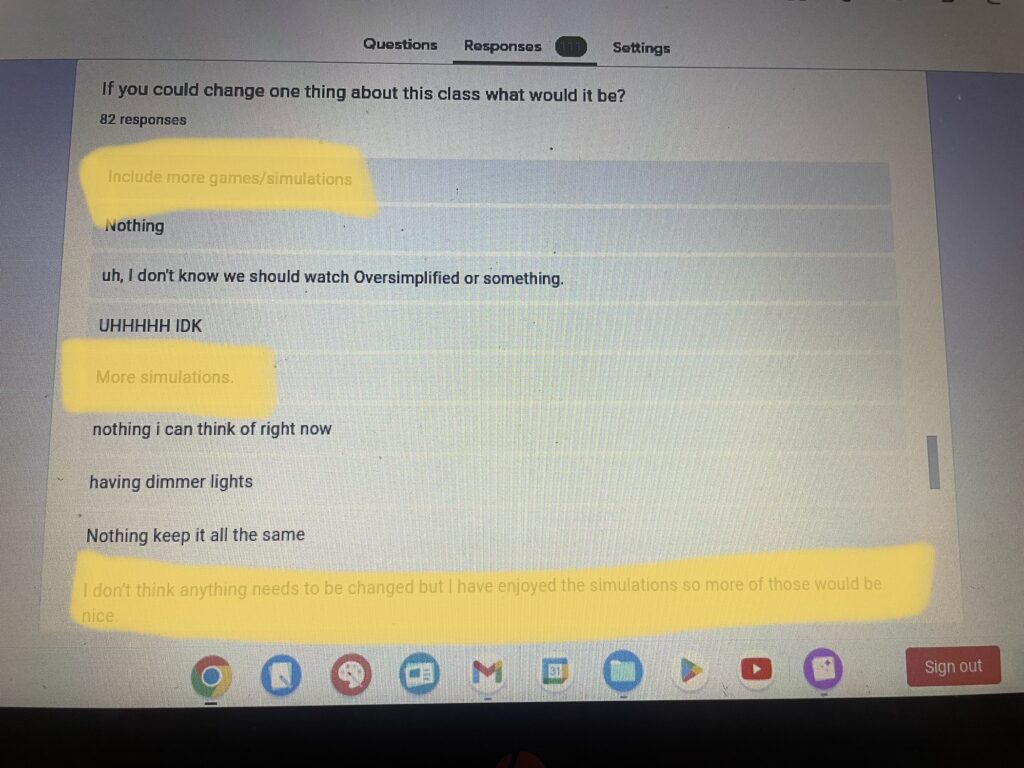
Check out one of my recent simulations below with a link to the lesson provided!
- Simulation : I recently completed a simulation on labor unions during the industrial revolution, and the simulation had students creating paper airplanes in an assembly line. The students picked or were assigned a role in the simulation: CEO (makes a ton of “money” and is able to fire people) Bosses (oversee the manufacturing and make good money) Union Reps (try to get as many people in the union as possible and stage a strike) and Workers (do your assigned task in the assembly line and try to get paid). The goal is for the Union Reps to stage a strike and demand better wages (candy), working conditions and less hours while being secretive and not being fired. The goal for the CEO is to make as much money as possible and to fire the two union reps, if they do they win and keep all the candy. Different classes had different outcomes, but they I asked the students to begin discussing their experiences with one another and then we shared out to the class and began a class discussion on the simulation. I heard things like the labor union was necessary for us to get better pay because if we stood alone then we would be fired. Or working conditions were horrible and we cannot imagine if we were living 100 years ago and had to actually work in a factory. I could see them beginning to make the connections and they could see themselves applying it to readings or notes from class. It was fun, it was silly, but it was also memorable and effective.
- Labor Unions (If you want a more complete lesson plan feel free to reach out, and leave a comment below!)
HISTORICAL THINKING IN ACTION
I recently tried a new MTV strategy with my American History students called: The Story Routine. I am currently in an industrialization and urbanization unit, and this is the biggest unit with the most standards of the year. There are also so many concepts that are intertwined together and I have found it difficult to notice if students are able to capture all of them together. However, the story routine from the book and the video gave me an awesome idea:
- I provided students with 5-6 pictures that they could choose from and these were pictures of different people throughout the Industrial Revolution (Child Laborers, Coal Mine Workers, Tenement Residents, CEO’s, etc). They picked one of the pictures and wrote a story about that person’s life. They could give them a name, a location, a job and just write about that person’s life. Is it a good one? Is it difficult? What do they experience? How does their life turn out?
- I allowed them to bounce ideas off of their classmates and read rough drafts to their classmates, and if they were able to rework their stories they wanted.
- I participated in this with every class, and wrote a different story for each picture and used this as a model for my students if they would like it.
- This was simply a participation grade, and I used it as data points for myself: are they using concepts that we’ve discussed, if so which ones?
Results!
My students absolutely crushed it and thoroughly enjoyed the activity. They were given ten minutes to write these stories and every class asked for extra time to finish, they were so eager to talk about the people they chose. When they finished, every student participated in reading their story with another, and many students were volunteering to read their stories to the class. It was so fun to see how engaged they were and they understood the concepts tied to Industrialization and Urbanization and were citing evidence from our course into their stories. It went so well that I plan on this becoming a weekly routine for my classes! Check out some work below!
Challenges: Some students felt that there was not enough direction, and wanted this activity to be more structured. I encouraged them to just write whatever came to mind
For next time: I would have students read many different students stories, and see if they can add on to them at all.
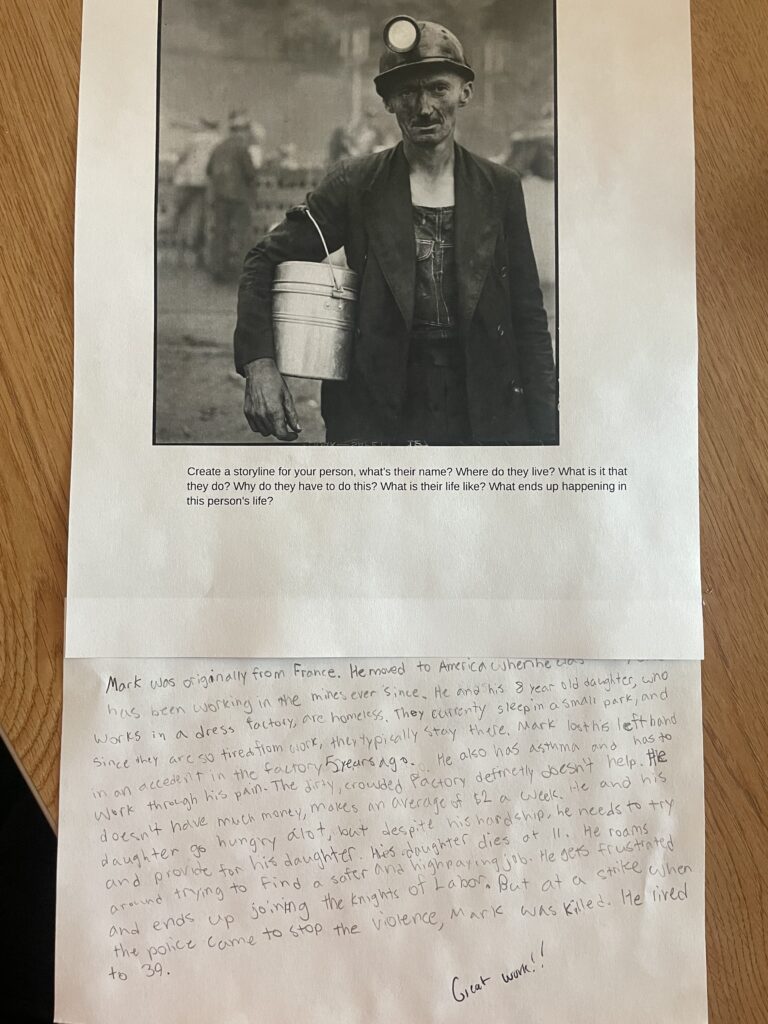
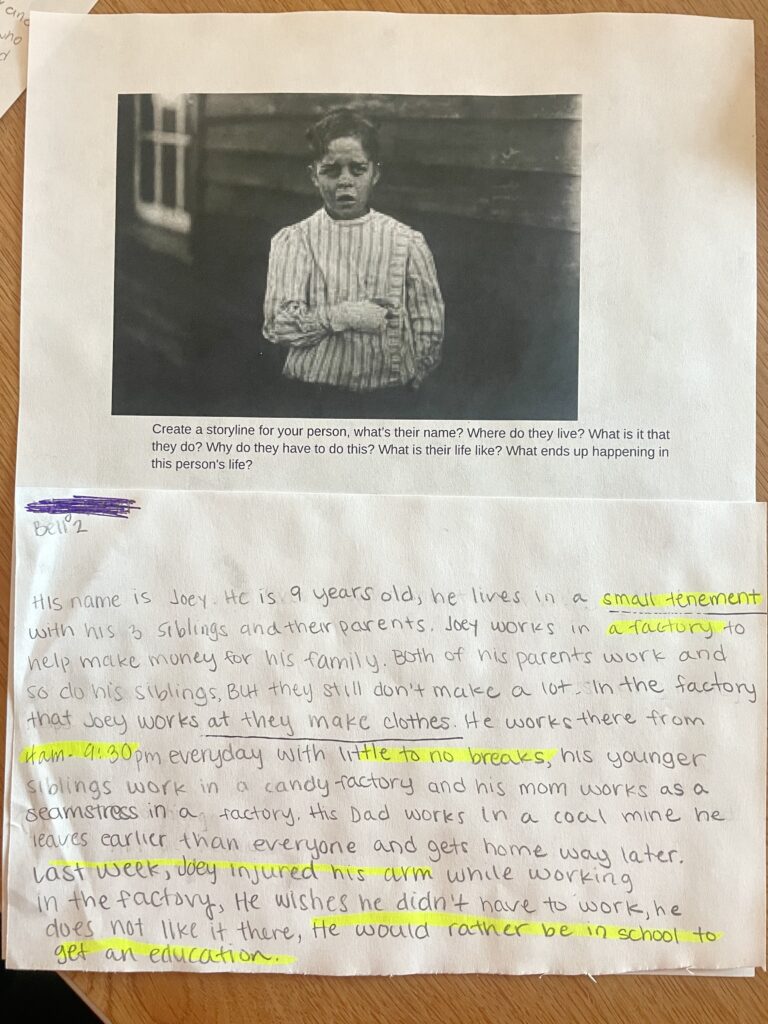
MTV and TCE
The nice thing about MTV is that it aligns with Miami’s TCE Thresholds, and the first is “Curriculum is more than standards, textbooks and courses of study.” We need to cultivate the minds of our students so that they can become critical thinkers and use the content and concepts in our curriculum and apply it to their own lives.
- The MTV strategy that I used fits into this threshold as the students were using creative thinking skills to explain the content and concepts of our curriculum. It helped the students move past the curriculum to use their creativity and bring their knowledge to life.
The second TCE threshold that aligns with MTV is “Teaching is/as intellectual engagement.” The question from the TCE Thresholds document that really sold me that it aligns with MTV is “how can you tell when teaching/learning is going on” which is essentially MTV in a nutshell, teaching and learning should not be imaginary things that are happening in your classroom but they should be tangible and visible. MTV provides teachers with the necessary tools to ensure this is a reality in their classrooms.
- The story writing allowed me to see the students thinking in a tangible way, as I was able to read and listen to their ideas come to life in a story. They took one look at a picture, and began to start connecting the dots, and then did this with other students as well. It also helped that I was doing this exercise with the students as well, so it felt more to them like an engagement between all parties involved.
Social Learning and Sharing!
Interactions with other MTV blogs:
https://thinkingpathwayz.weebly.com/blog/unpacking-thinking
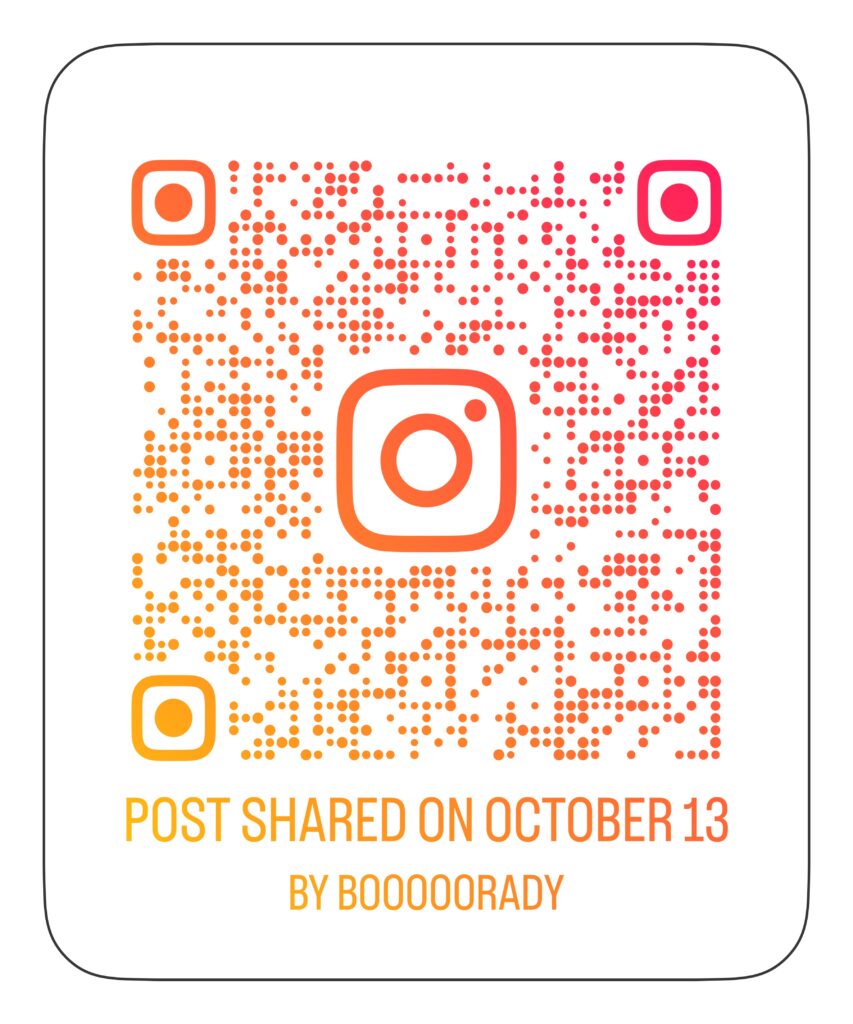
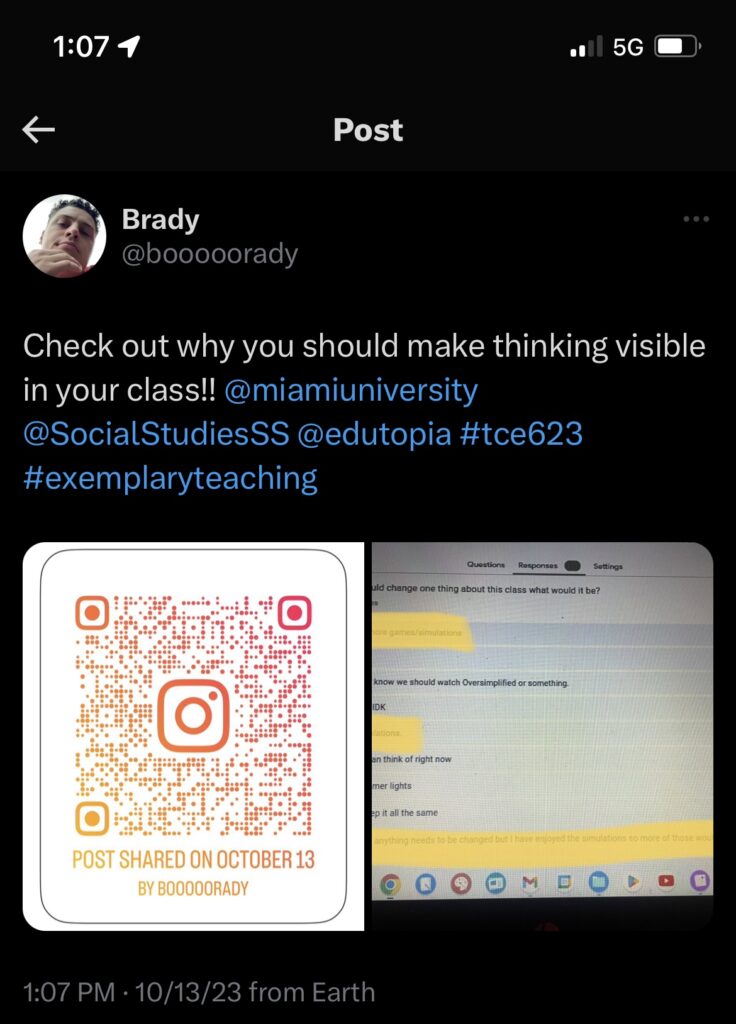
3 responses to “Making Thinking Visible: Bringing History to Life”
-
Awesome job! What a fun activity! I would love to have seen it in action. I’m sure your students will remember this activity as well as your simulations for years to come. I love the relationship that yiu have built with your students. It’s great that you remember what it is like to be a student as well as gain feedback from your students to be an effective educator. I also try to add engaging activities into my units such as escape rooms. I would love to try this strategy for science. Thanks for sharing!
-
Brady: Thanks for explaining your recent MTV strategy trial. I really liked the ways you used it in your class. I think that my students would also enjoy something like this! It allows you to differentiate the task using controlled choice, while still being on topic. It is also a great way for my students to write. They would pick a picture that is of interest to them instead of having to write around something I chose. Improving writing is a huge area of need for my students right now and I think this strategy is a great way to incorporate more writing. It is also a fun way for students to be creative while applying critical thinking and their knowledge of a subject. Thanks for sharing!
-
Hi Brady!
What a great blog post! I love the quote you implemented, “Teaching is not telling.” I feel like often times my teaching team feels pressure from above to stay on pace with the curriculum maps. However, we HAVE to stay on target with the map in order to get through everything that we need to in 1 school year, there is no wiggle room. To me, sometimes it feels like I am telling the students the information to cover the content. But what is that really doing for my students? I have accepted getting behind on the curriculum map by 2-3 weeks and it is what it is. I know my students best and I am not just going to check boxes off, because that is not what is best for the students to learn as well as not what’s best for me to do my job to its entirety.I love the survey you gave your students, and that you are listening to their thoughts and suggestions! Not only that, but you are implementing them! Such a cool simulation that you did! Nice work taking photographs of your students activities. This is such a nice addition to your blog post, and makes me want to include those next time.
Check out this blog post I found! https://blogs.cisco.com/education/how-making-thinking-visible-helps-teachers-and-students It is very insightful, and you may get some new ideas for your next MTV strategy implementation!

Awesome job! What a fun activity! I would love to have seen it in action. I’m sure your students will remember this activity as well as your simulations for years to come. I love the relationship that yiu have built with your students. It’s great that you remember what it is like to be a student as well as gain feedback from your students to be an effective educator. I also try to add engaging activities into my units such as escape rooms. I would love to try this strategy for science. Thanks for sharing!
Brady: Thanks for explaining your recent MTV strategy trial. I really liked the ways you used it in your class. I think that my students would also enjoy something like this! It allows you to differentiate the task using controlled choice, while still being on topic. It is also a great way for my students to write. They would pick a picture that is of interest to them instead of having to write around something I chose. Improving writing is a huge area of need for my students right now and I think this strategy is a great way to incorporate more writing. It is also a fun way for students to be creative while applying critical thinking and their knowledge of a subject. Thanks for sharing!
Hi Brady!
What a great blog post! I love the quote you implemented, “Teaching is not telling.” I feel like often times my teaching team feels pressure from above to stay on pace with the curriculum maps. However, we HAVE to stay on target with the map in order to get through everything that we need to in 1 school year, there is no wiggle room. To me, sometimes it feels like I am telling the students the information to cover the content. But what is that really doing for my students? I have accepted getting behind on the curriculum map by 2-3 weeks and it is what it is. I know my students best and I am not just going to check boxes off, because that is not what is best for the students to learn as well as not what’s best for me to do my job to its entirety.
I love the survey you gave your students, and that you are listening to their thoughts and suggestions! Not only that, but you are implementing them! Such a cool simulation that you did! Nice work taking photographs of your students activities. This is such a nice addition to your blog post, and makes me want to include those next time.
Check out this blog post I found! https://blogs.cisco.com/education/how-making-thinking-visible-helps-teachers-and-students It is very insightful, and you may get some new ideas for your next MTV strategy implementation!